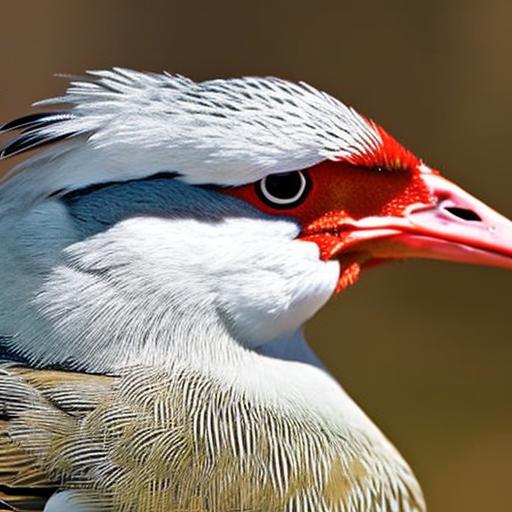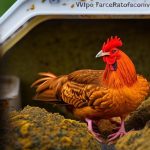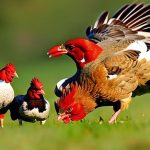Raising geese and chickens together can be a beneficial practice for farmers and homesteaders. Geese and chickens have different characteristics and behaviors that complement each other, making them a great combination for sustainable farming. Geese are known for their excellent foraging abilities, while chickens are efficient at pest control. By raising them together, farmers can maximize the benefits of both species and create a more sustainable and productive farm.
One of the main benefits of raising geese and chickens together is their complementary foraging abilities. Geese are excellent grazers and can efficiently convert grass and other vegetation into meat and eggs. They have a unique ability to digest fibrous plant material, making them ideal for grazing on pasture. Chickens, on the other hand, are great at scratching and pecking the ground, which helps control pests like insects and weeds. By allowing geese and chickens to forage together, farmers can create a more balanced ecosystem on their farm, reducing the need for chemical inputs and promoting natural pest control.
Another benefit of raising geese and chickens together is the diversity of products they provide. Geese are primarily raised for meat production, while chickens are raised for both meat and egg production. By having both species on the farm, farmers can diversify their product offerings and cater to different market demands. This can help increase profitability and provide a more stable income stream throughout the year.
Key Takeaways
- Raising geese and chickens together can provide numerous benefits for sustainable farming.
- Creating a safe and comfortable living environment is crucial for the health and well-being of geese and chickens.
- Meeting the dietary needs of geese and chickens requires careful attention to their nutritional requirements.
- Identifying and preventing common health issues is essential for maintaining a healthy flock.
- Raising goslings and chicks together requires careful management to ensure their safety and well-being.
The Advantages of Keeping Geese and Chickens for Sustainable Farming
Raising geese and chickens together contributes to sustainable farming practices in several ways. Firstly, both species are well-suited to free-range or pasture-based systems, which promote animal welfare and reduce environmental impact. By allowing geese and chickens to graze on pasture, farmers can provide them with a more natural diet while minimizing the need for expensive feed inputs.
Secondly, geese and chickens are efficient converters of feed into meat and eggs. Geese, in particular, have a high feed conversion ratio, meaning they can produce a significant amount of meat from a relatively small amount of feed. This makes them an efficient choice for sustainable meat production. Chickens, on the other hand, are known for their high egg production rates, making them a valuable asset for sustainable egg production.
Lastly, raising geese and chickens together can help improve soil health and fertility. Geese and chickens naturally fertilize the soil with their manure, which is rich in nutrients. By allowing them to graze on pasture, farmers can distribute this natural fertilizer evenly across their land, promoting healthy plant growth and reducing the need for synthetic fertilizers.
Creating a Safe and Comfortable Living Environment for Geese and Chickens
Creating a safe and comfortable living environment is crucial for the health and well-being of geese and chickens. Both species have specific housing requirements that need to be met to ensure their safety and comfort.
For geese, a secure shelter is essential to protect them from predators and harsh weather conditions. A goose house should have solid walls and a sturdy roof to provide protection from wind, rain, and extreme temperatures. It should also have adequate ventilation to prevent the buildup of moisture and ammonia gases. Additionally, geese require access to water for swimming and grooming, so a small pond or pool should be provided within their enclosure.
Chickens also require a secure shelter to protect them from predators and the elements. A chicken coop should have solid walls and a predator-proof floor to prevent access from burrowing animals. It should also have proper ventilation to maintain good air quality inside the coop. Additionally, chickens need nesting boxes for laying eggs and perches for roosting at night.
In terms of space requirements, geese generally require more space than chickens due to their larger size. A rule of thumb is to provide at least 10 square feet of outdoor space per goose and 2-4 square feet of indoor space per goose. For chickens, a minimum of 4 square feet of outdoor space per bird and 1-2 square feet of indoor space per bird is recommended.
Feeding and Nutrition: Meeting the Dietary Needs of Geese and Chickens
| Metrics | Geese | Chickens |
|---|---|---|
| Protein Requirement | 16-20% | 18-20% |
| Calcium Requirement | 2-4% | 3-4% |
| Phosphorus Requirement | 0.5-0.6% | 0.45-0.5% |
| Vitamin A Requirement | 10,000-20,000 IU/kg | 5,000-10,000 IU/kg |
| Vitamin D Requirement | 1,000-2,000 IU/kg | 500-1,000 IU/kg |
| Vitamin E Requirement | 20-30 IU/kg | 10-20 IU/kg |
Meeting the dietary needs of geese and chickens is essential for their health and productivity. Both species have specific dietary requirements that need to be met through proper feeding practices.
Geese are primarily grazers and require access to fresh pasture or grass. They have a unique ability to digest fibrous plant material, making them excellent foragers. However, they also require supplemental feed to meet their nutritional needs, especially during periods of high energy demand, such as breeding or molting. A balanced diet for geese should consist of a combination of pasture, grains, and protein-rich feeds. High-quality water should also be provided at all times.
Chickens, on the other hand, require a more balanced diet that includes grains, protein, vitamins, and minerals. A commercial poultry feed formulated specifically for chickens is usually the best option to ensure they receive all the necessary nutrients. However, chickens also benefit from access to fresh pasture and insects, which provide additional nutrients and help promote natural foraging behaviors.
It’s important to note that geese and chickens have different feeding behaviors and preferences. Geese prefer to graze on grass and other vegetation, while chickens are more opportunistic feeders and will eat a wide variety of foods. When feeding geese and chickens together, it’s important to provide separate feeding areas to prevent competition and ensure each species gets the appropriate amount of food.
Health and Disease Prevention: Identifying Common Health Issues in Geese and Chickens
Like any livestock, geese and chickens are susceptible to various health issues and diseases. It’s important for farmers to be aware of common health problems and take preventive measures to keep their flocks healthy.
Common health issues in geese include respiratory infections, parasites, and nutritional deficiencies. Respiratory infections can be caused by bacteria or viruses and can lead to symptoms such as coughing, sneezing, and difficulty breathing. Parasites, such as mites and worms, can also affect geese and cause weight loss, poor feather quality, and general weakness. Nutritional deficiencies can occur if geese are not receiving a balanced diet, leading to poor growth, reduced egg production, and weakened immune system.
Chickens are also prone to respiratory infections, parasites, and nutritional deficiencies. In addition, they are susceptible to diseases such as coccidiosis, Marek’s disease, and avian influenza. Coccidiosis is a common intestinal disease caused by a protozoan parasite and can cause diarrhea, weight loss, and reduced egg production. Marek’s disease is a viral disease that affects the nervous system of chickens and can cause paralysis and death. Avian influenza is a highly contagious viral disease that affects both chickens and geese and can cause severe illness and death.
To prevent health issues in geese and chickens, farmers should practice good biosecurity measures, such as regular cleaning and disinfection of housing areas, proper waste management, and limiting contact with wild birds. Vaccinations are also available for certain diseases and can help protect the flock from common illnesses. Additionally, providing a balanced diet, clean water, and a stress-free environment can help boost the immune system of geese and chickens and reduce the risk of disease.
Breeding and Reproduction: Raising Goslings and Chicks Together

Breeding geese and chickens can be a rewarding experience for farmers who want to expand their flock or raise young birds for meat or egg production. Raising goslings and chicks together can also help promote socialization and reduce stress for the young birds.
Breeding geese involves providing a suitable nesting area for the female goose and ensuring she has access to a male goose for mating. Geese are monogamous and will mate for life, so it’s important to select compatible pairs. Once the female goose lays her eggs, she will incubate them for about 30 days until they hatch. During this time, it’s important to provide a quiet and secure area for the nesting goose to minimize disturbances.
Breeding chickens is a similar process, but with some key differences. Chickens are not monogamous and will mate with multiple partners. To ensure successful breeding, it’s important to provide a ratio of one rooster for every 8-10 hens. The female chicken will lay eggs in a nesting box, and if left undisturbed, she will incubate them until they hatch in about 21 days. However, many farmers prefer to use artificial incubators to control the hatching process and increase hatch rates.
Raising goslings and chicks together can help promote socialization and reduce stress for the young birds. It’s important to provide a safe and warm environment for the young birds, as they are more vulnerable to predators and temperature fluctuations. A brooder box or separate enclosure with heat lamps or brooder plates should be provided to keep the goslings and chicks warm during their first few weeks of life. It’s also important to provide them with appropriate feed and water that is easily accessible.
Managing Flock Dynamics: Maintaining Harmony Between Geese and Chickens
Managing flock dynamics is crucial when raising geese and chickens together to maintain harmony and prevent aggression or bullying between the two species.
Geese are generally more dominant than chickens and may exhibit aggressive behaviors towards them if not properly managed. To prevent aggression, it’s important to provide enough space for both species to move around and establish their own territories. Separate feeding areas should also be provided to prevent competition and ensure each species gets the appropriate amount of food. Additionally, providing plenty of enrichment, such as toys or natural materials, can help distract the birds and reduce aggression.
Chickens, on the other hand, may be more prone to bullying by geese due to their smaller size. To prevent this, it’s important to provide hiding places or elevated perches for the chickens to escape from the geese if needed. It’s also important to monitor the flock closely and intervene if any aggressive behaviors are observed. Separating the birds temporarily or providing visual barriers can help reduce aggression and allow the birds to establish a more harmonious hierarchy.
Egg Production: Maximizing Egg Yields from Geese and Chickens
Egg production is an important aspect of raising geese and chickens together, as it provides a valuable source of income for farmers. Maximizing egg yields requires proper management and attention to the specific needs of each species.
Geese are not as prolific egg layers as chickens, but they can still produce a significant number of eggs if managed properly. Geese typically lay their eggs in a nest on the ground or in a nesting box provided by the farmer. To maximize egg production, it’s important to provide a quiet and secure area for the geese to lay their eggs, as disturbances can disrupt their laying behavior. Collecting eggs regularly and providing clean nesting material can also help encourage consistent egg laying.
Chickens are known for their high egg production rates, but there are still ways to maximize their yields. Providing a balanced diet that meets their nutritional needs is crucial for optimal egg production. Additionally, ensuring they have access to clean water at all times is important, as dehydration can negatively impact egg production. Collecting eggs regularly and providing clean nesting boxes can also help prevent the hens from becoming broody and encourage them to continue laying.
Marketing and Selling Geese and Chicken Products: Opportunities and Challenges
There are various opportunities for marketing and selling geese and chicken products, but there are also challenges that farmers need to be aware of.
One opportunity for marketing geese and chicken products is through direct sales to consumers. Many people are interested in purchasing locally-raised, organic, or free-range meat and eggs, and farmers can tap into this market by promoting the unique qualities of their products. Farmers can sell their products at farmers markets, through community-supported agriculture (CSA) programs, or directly from their farm. They can also consider value-added products, such as processed meats or specialty eggs, to cater to specific market demands.
Another opportunity for marketing geese and chicken products is through wholesale or restaurant sales. Many restaurants and food establishments are looking for high-quality, sustainably-raised meat and eggs to include in their menus. Farmers can reach out to local restaurants or food distributors to explore potential partnerships or supply agreements.
However, there are also challenges that farmers may face when marketing and selling geese and chicken products. One challenge is competition from larger-scale producers who can offer lower prices due to economies of scale. To overcome this challenge, farmers can focus on promoting the unique qualities of their products, such as their sustainable farming practices or superior taste and quality.
Another challenge is meeting regulatory requirements for food safety and labeling. Farmers need to ensure they comply with local regulations regarding the processing, packaging, and labeling of their products. This may require additional investments in infrastructure or training to meet these requirements.
The Rewards and Challenges of Keeping Geese and Chickens Together
Raising geese and chickens together can be a rewarding practice for farmers and homesteaders. The benefits of raising them together include complementary foraging abilities, diversification of products, and contributions to sustainable farming practices. However, there are also challenges that farmers need to be aware of, such as managing flock dynamics, preventing and treating health issues, and marketing and selling their products.
By understanding the specific needs and behaviors of geese and chickens, farmers can create a safe and comfortable living environment for their flocks. Providing appropriate housing, feeding a balanced diet, and implementing good biosecurity measures can help prevent health issues and promote the overall well-being of the birds.
While there are challenges in raising geese and chickens together, the rewards can outweigh them. By maximizing egg yields, diversifying product offerings, and tapping into niche markets, farmers can create a sustainable and profitable business. Ultimately, keeping geese and chickens together can contribute to a more holistic and regenerative farming system that benefits both the farmer and the environment.
If you’re considering keeping geese with chickens, it’s important to understand the dynamics and requirements of both species. While chickens and geese can coexist peacefully, there are certain considerations to keep in mind. One helpful resource to guide you through this process is an article on Poultry Wizard titled “How to Care for Geese and Chickens Together.” This article provides valuable insights into the compatibility of these two birds and offers practical tips on housing, feeding, and managing their unique needs. To learn more about keeping geese with chickens, check out the article here.
FAQs
What are the benefits of keeping geese with chickens?
Keeping geese with chickens can provide several benefits such as increased protection against predators, improved foraging, and better egg production.
What are the potential drawbacks of keeping geese with chickens?
One potential drawback of keeping geese with chickens is that geese can be aggressive towards chickens, especially during mating season. Additionally, geese require more space and water than chickens, which can be a challenge for some backyard farmers.
How do you introduce geese to a flock of chickens?
It is important to introduce geese to a flock of chickens slowly and carefully. Start by keeping the geese in a separate enclosure next to the chicken coop for a few days, allowing them to get used to each other’s presence. Then, gradually allow them to interact under supervision until they are comfortable with each other.
What should you feed geese and chickens when they are kept together?
Geese and chickens have different dietary needs, so it is important to provide them with separate feeders and waterers. Geese require a diet that is higher in protein and lower in calcium than chickens, so they should be fed a specialized waterfowl feed. Chickens can eat a standard layer feed.
How do you protect geese and chickens from predators?
To protect geese and chickens from predators, it is important to provide a secure coop and run that is covered with wire mesh to prevent entry from above and below. Additionally, it is important to lock the coop at night and provide adequate lighting to deter nocturnal predators.
Meet Walter, the feathered-friend fanatic of Florida! Nestled in the sunshine state, Walter struts through life with his feathered companions, clucking his way to happiness. With a coop that’s fancier than a five-star hotel, he’s the Don Juan of the chicken world. When he’s not teaching his hens to do the cha-cha, you’ll find him in a heated debate with his prized rooster, Sir Clucks-a-Lot. Walter’s poultry passion is no yolk; he’s the sunny-side-up guy you never knew you needed in your flock of friends!







